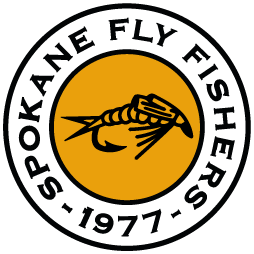By Ken Moore
Recently I was reviewing my fishing journal from last year when I was reminded of a fishing trip taken on the St. Joe River. My notes revealed the coolness of the fall morning, the sun breaking through the fog that was on the water. The leaves were in full fall colors and there was even a bull elk bugling upstream from my location. As nice and scenic as that morning was, my goal for that trip was to work on dry fly presentations in pocket water. My objective for the entire day was to fish one pod of cutthroats, and not move more than 20 feet from where I started for the entire day. Yes, you read that correctly – I didn’t move my location all day. I worked on different presentation styles, casting different tippet and leader combinations, different types of flies, and the same fly in varying sizes. Did it make a difference where the sun was in the sky? How far out would a fish travel to survey my fly presentation? How hard could I slap the water or did the fish require a gentler presentation? I studied different ways of applying floatant to the hackle vs the whole fly. What would happen if I knelt or stood? How close could I get to these fish without putting them off the bite? If I put the fish off thru carelessness, how long did it take for the fish to begin to feed again?
I hope you get the idea, my point today is to encourage you to not “just go fishing” but turn it into a mental game – an educational experience for your fishing soul. The beauty of our sport is you will never know it all. It’s not that “the fish were off the bite today”, maybe the better question is, do I have the skill sets to find and entice a fish to try a piece of fur or feather tied on a hook. Trust me they are eating somewhere in that watershed. Often, it is just a matter of presentation.
So, it’s March and by now you are probably getting weary of sitting in the old La-Z-boy chair. With your permission, allow me to suggest some things you could be doing now to prepare for a very successful fly-fishing season; Practice your casting. Practice casting in the wind, on your knees, using your non-dominant arm. The most important thing I can suggest here is to practice your accuracy. I have had guests in my boat that were happy to show me how far they could cast but they couldn’t hit a swimming pool at 30 yards. Start with a hula hoop ring and work with it until you can consistently hit a paper plate at10, 15, 20, and 30 yards.
That will work for 90+% of your fishing needs for trout, pike, and bass. Practice your roll cast, practice casting off of your non-dominant shoulder. Study your entomology – if you are a proponent for match the hatch you do really need to understand the difference between a caddis and mayfly and when to use an emerger versus a nymph. Where should I actually throw a terrestrial (hopper, ant or beetle) to increase my chances of a hookup? (hint, it is not in the middle of the river)
Knots – let’s be honest for a moment. We could all be faster with our knot tying. Do you want to miss all those rising fish because you are either slow or unable to tie on your fly? You can imagine the looks I get when I am practicing my knots on a flight to Seattle. My go-to favorite hurry up knot is the Davy knot, (https://www.youtube.com/watch?v=-NTVZAZ0xQA) learn it, give it a try and let me know what you think.
This is the time of year to organize your gear, not only your fishing gear but maybe your camping gear. Visit your local fly shop, there is new gear that needs serious consideration in joining your family. Plus, this is one of the best times of the year for sales because the shop is trying to clear out last year’s inventory. Inspect and clean your fly lines, buy new leader and tippets. Organize your fly boxes. Crimp the barbs on your hooks now, so that it is one less thing to do on the water later. Read a book or watch YouTube videos on something that you have always wanted to try but just haven’t yet. Talk to other fly fishers and ask what are their go-to flies? If you haven’t tried those flies, buy or tie a couple and give them a try. Start a fishing journal to
record what works, and where you went so you can re-live that perfect day.
But the biggest tip I can give you for this year is to pull out your calendar and set some dates. Dates to go fishing, maybe to new locations, with new fishing partners, and new equipment to try (a 4 weight rod versus your tried and true 5 weight rod.) Shameless plug for the club: Sign up for an outing. This is why the club publishes the outings dates and locations so early in the year. A club outing is an excellent way to fish new waters, maybe new species of fish with someone that knows where to go and what to cast. Another huge benefit is you make new friends to fish with! My hope for you this year is that you will approach the year and water with a plan to always explore and not be afraid to try something new.
Fish it well, Ken Moore
